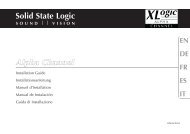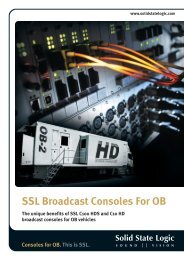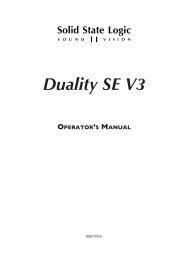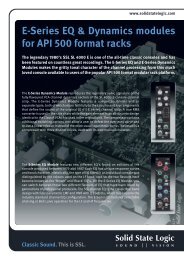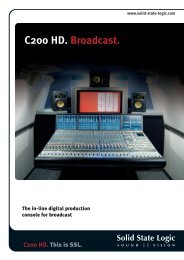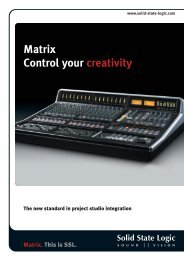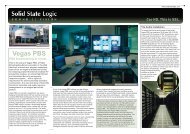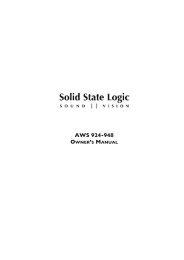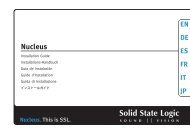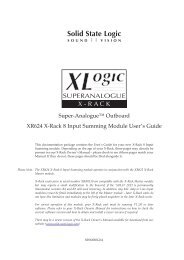Mackie Control Surfaces Help Working with the ... - Solid State Logic
Mackie Control Surfaces Help Working with the ... - Solid State Logic
Mackie Control Surfaces Help Working with the ... - Solid State Logic
Create successful ePaper yourself
Turn your PDF publications into a flip-book with our unique Google optimized e-Paper software.
<strong>Mackie</strong> <strong>Control</strong> <strong>Surfaces</strong> <strong>Help</strong>file://C:\Documents and Settings\damiene\Local Settings\Temp\~hhBF48.htmPage 2 of 3722/07/2009<strong>Mackie</strong> <strong>Control</strong> ButtonsAssigning <strong>the</strong> Faders to Tracks or Buses<strong>Control</strong>ling Specific Tracks or Buses, or Specific Banks of Tracks or BusesEditing Parameters on Tracks and BusesPlayback, Looping, and LocatingSelecting DataRecordingAdding, Deleting, and Cloning TracksZoomingUsing <strong>Mackie</strong> MetersHiding and Showing Tracks<strong>Control</strong>ling Volume, Pan, and O<strong>the</strong>r Track or Bus Parameters<strong>Control</strong>ling Effects and BusesConfiguring EQsConfiguring Dynamics ProcessorsAutomating <strong>the</strong> <strong>Mackie</strong> <strong>Control</strong>Saving, Undoing, and RedoingFilling Out Dialog BoxesConnecting and DisconnectingYou can connect <strong>the</strong> <strong>Mackie</strong> <strong>Control</strong> to your MIDI interface by using <strong>the</strong> <strong>Mackie</strong> <strong>Control</strong>'s MIDI IN andMIDI OUT ports. You can add as many <strong>Mackie</strong> XT extension units as you have available ports on your MIDIinterface (see To Configure an XT Unit).To Connect <strong>the</strong> <strong>Mackie</strong> <strong>Control</strong> (or XT) to SONAR1. Before you turn on <strong>the</strong> <strong>Mackie</strong> <strong>Control</strong> (or XT), connect MIDI cables from its MIDI OUT port to yourMIDI interface's MIDI IN port, and from its MIDI IN port to your MIDI interface's MIDI OUT port.2. Turn on <strong>the</strong> <strong>Mackie</strong> <strong>Control</strong> (or XT).3. Launch SONAR.4. Use <strong>the</strong> Options-<strong>Control</strong> <strong>Surfaces</strong> command to open <strong>the</strong> <strong>Control</strong> <strong>Surfaces</strong> dialog.5. Click <strong>the</strong> Add button , which opens <strong>the</strong> <strong>Control</strong> Surface Settings dialog.6. In <strong>the</strong> <strong>Control</strong> Surface field, use <strong>the</strong> drop-down menu to select <strong>the</strong> <strong>Mackie</strong> <strong>Control</strong> option (if you'reconnecting a <strong>Mackie</strong> XT instead, select <strong>Mackie</strong> <strong>Control</strong> XT).7. In <strong>the</strong> Input Port field, select <strong>the</strong> MIDI port that you want <strong>the</strong> <strong>Mackie</strong> <strong>Control</strong> (or XT) to send data to
<strong>Mackie</strong> <strong>Control</strong> <strong>Surfaces</strong> <strong>Help</strong>file://C:\Documents and Settings\damiene\Local Settings\Temp\~hhBF48.htmPage 3 of 3722/07/2009SONAR through.8. In <strong>the</strong> Output Port field, select <strong>the</strong> MIDI port that you want <strong>the</strong> <strong>Mackie</strong> <strong>Control</strong> (or XT) to receive datafrom SONAR through.9. Click OK--<strong>the</strong> <strong>Mackie</strong> <strong>Control</strong> name appears in <strong>the</strong> <strong>Control</strong> <strong>Surfaces</strong> dialog under Connected <strong>Surfaces</strong>.10. Click Close.The <strong>Mackie</strong> <strong>Control</strong>'s faders should snap to <strong>the</strong> positions of your SONAR track volume settings. Move someof <strong>the</strong> <strong>Mackie</strong> <strong>Control</strong> faders and watch <strong>the</strong> SONAR volume settings change. If <strong>the</strong> settings don't change, trydisconnecting <strong>the</strong> <strong>Mackie</strong> <strong>Control</strong> and <strong>the</strong>n reconnecting: see below.To Disconnect <strong>the</strong> <strong>Mackie</strong> <strong>Control</strong> from SONAR1. Use <strong>the</strong> Options-<strong>Control</strong> <strong>Surfaces</strong> command to open <strong>the</strong> <strong>Control</strong> <strong>Surfaces</strong> dialog.2. In <strong>the</strong> <strong>Control</strong> Surface column, select <strong>Mackie</strong> <strong>Control</strong> so that it is highlighted.3. Click <strong>the</strong> Delete button .4. Click Close.SONAR disconnects <strong>the</strong> <strong>Mackie</strong> <strong>Control</strong>.The <strong>Control</strong> <strong>Surfaces</strong> ToolbarSONAR's <strong>Control</strong> <strong>Surfaces</strong> toolbar contains a drop-down menu of all connected control surfaces, including<strong>the</strong> <strong>Mackie</strong> <strong>Control</strong>. To display <strong>the</strong> toolbar, use <strong>the</strong> View-Toolbars command to open <strong>the</strong> Toolbars dialog,and check <strong>the</strong> <strong>Control</strong> <strong>Surfaces</strong> option. The toolbar displays <strong>the</strong> currently selected group of tracks, <strong>the</strong> nameof <strong>the</strong> bus that <strong>the</strong> <strong>Mackie</strong>'s Master fader controls, and <strong>the</strong> Jog Wheel resolution.Note: The toolbar is for display purposes only. To enable ano<strong>the</strong>r control surface, use <strong>the</strong> Options-<strong>Control</strong><strong>Surfaces</strong> command. To change <strong>the</strong> bank of tracks that <strong>the</strong> control surface controls, use <strong>the</strong> buttons on <strong>the</strong>control surface itself. Use <strong>the</strong> drop-down menu on <strong>the</strong> toolbar to choose what control surface <strong>the</strong> toolbardisplays information for. Click <strong>the</strong> Properties button at <strong>the</strong> end of <strong>the</strong> toolbar to display <strong>the</strong> property page(interface) of <strong>the</strong> currently displayed control surface.Using <strong>the</strong> <strong>Mackie</strong> <strong>Control</strong> Property PageYou can set several options in <strong>the</strong> <strong>Mackie</strong> <strong>Control</strong> property page. Once you set your options, you can save<strong>the</strong>m by typing a name for <strong>the</strong>m in <strong>the</strong> Presets window, and clicking <strong>the</strong> Disk icon. You can create and saveas many different presets as you want.The options include:Function Buttons--you can assign each of <strong>the</strong> 8 Function buttons to a different SONAR menucommand, in addition to <strong>the</strong> commands that you can trigger by pressing <strong>the</strong> M1 button and each of <strong>the</strong>buttons simultaneously.Jog Wheel Resolution--you can choose by what increment you want <strong>the</strong> Now time to move when youmove <strong>the</strong> Jog Wheel.Transport Resolution--you can choose by what increment you want <strong>the</strong> Now time to move when youpress <strong>the</strong> Rewind or Fast Fwd buttons.Time Display Format--you can choose what time format <strong>the</strong> <strong>Mackie</strong> <strong>Control</strong> time display uses todisplay <strong>the</strong> Now time.Option to Disable Fader Movements--you can stop <strong>the</strong> faders from moving to minimize noise during
<strong>Mackie</strong> <strong>Control</strong> <strong>Surfaces</strong> <strong>Help</strong>file://C:\Documents and Settings\damiene\Local Settings\Temp\~hhBF48.htmPage 4 of 3722/07/2009recording. Option to Disable Relay Click--this option enables/disables <strong>the</strong> audible click for <strong>the</strong> transport buttons(play, stop, etc.). Option to Disable LCD Updates--if you have a lot of parameters displayed on <strong>the</strong> LCD screen,updating can take a long time. You may choose occasionally to disable <strong>the</strong> visual updating. Solo Selects Channel--If checked, this option allows you to select a track on <strong>the</strong> <strong>Mackie</strong> <strong>Control</strong>Surface by soloing <strong>the</strong> track in SONAR. Fader Touch Selects Channel--if checked, this option allows you to select a track on <strong>the</strong> <strong>Mackie</strong><strong>Control</strong> Surface by touching <strong>the</strong> track's fader in SONAR. Select Highlights Track--if checked, this option highlights a track in SONAR when selected on <strong>the</strong><strong>Mackie</strong> <strong>Control</strong> Surface. Also, if a track is highlighted in SONAR, <strong>the</strong> track is selected on <strong>the</strong> <strong>Mackie</strong><strong>Control</strong> Surface. Foot Switches--if you have any foot switches plugged into <strong>the</strong> <strong>Mackie</strong> <strong>Control</strong>, you can choose 2different SONAR commands to trigger <strong>with</strong> <strong>the</strong>m. Master Fader--if you have more than one main out in SONAR, you can choose which one <strong>the</strong> <strong>Mackie</strong>master fader controls. Configure Layout--if you connect one or more <strong>Mackie</strong> XT extension units, this button allows you tochoose which track or bus <strong>the</strong> first fader on each unit controls. Click <strong>the</strong> button, <strong>the</strong>n turn V-pot 1 oneach unit to select <strong>the</strong> track that <strong>the</strong> first track strip controls, <strong>the</strong>n click <strong>the</strong> button again.See <strong>the</strong> following procedures for step-by-step instructions:To Open <strong>the</strong> <strong>Mackie</strong> <strong>Control</strong> Property Page1. After you connect <strong>the</strong> <strong>Mackie</strong> <strong>Control</strong> to SONAR, make sure <strong>the</strong> <strong>Control</strong> <strong>Surfaces</strong> toolbar is visible. Todisplay <strong>the</strong> toolbar, use <strong>the</strong> View-Toolbars command to open <strong>the</strong> Toolbars dialog, and check <strong>the</strong><strong>Control</strong> <strong>Surfaces</strong> option.2. Make sure <strong>the</strong> name of <strong>the</strong> <strong>Mackie</strong> <strong>Control</strong> is displayed in <strong>the</strong> toolbar's dropdown menu of connectedcontrol surfaces.3. Click <strong>the</strong> Properties button that is at <strong>the</strong> right end of <strong>the</strong> toolbar.<strong>Mackie</strong> <strong>Control</strong> ButtonsPlease take a moment to view <strong>the</strong> various buttons on <strong>the</strong> <strong>Mackie</strong> <strong>Control</strong>, and <strong>the</strong> lexan overly, whichrenames some of <strong>the</strong> buttons for SONAR functionality:
<strong>Mackie</strong> <strong>Control</strong> <strong>Surfaces</strong> <strong>Help</strong>file://C:\Documents and Settings\damiene\Local Settings\Temp\~hhBF48.htmPage 5 of 3722/07/2009
<strong>Mackie</strong> <strong>Control</strong> <strong>Surfaces</strong> <strong>Help</strong>file://C:\Documents and Settings\damiene\Local Settings\Temp\~hhBF48.htmPage 6 of 3722/07/2009Assigning <strong>the</strong> Faders to Tracks or BusesYou can assign <strong>the</strong> <strong>Mackie</strong>'s faders to control SONAR's tracks, or buses:To assign <strong>the</strong> faders to tracks, find <strong>the</strong> Track button in <strong>the</strong> <strong>Control</strong> Group section of buttons, and pressit so that its light is on. The Assignment window displays tr when both <strong>the</strong> Track button in <strong>the</strong> <strong>Control</strong>Group section and <strong>the</strong> Tracks button in <strong>the</strong> Assignment section are depressed.To assign <strong>the</strong> faders to an bus, find <strong>the</strong> Aux button in <strong>the</strong> <strong>Control</strong> Group section of buttons, and press itso that its light is on. The Assignment window displays bu when both <strong>the</strong> Aux button in <strong>the</strong> <strong>Control</strong>Group section and <strong>the</strong> Tracks button in <strong>the</strong> Assignment section are depressed.To assign <strong>the</strong> faders to main outs, find <strong>the</strong> Main button in <strong>the</strong> <strong>Control</strong> Group section of buttons, andpress it so that its light is on. The Assignment window displays oP when both <strong>the</strong> Main button in <strong>the</strong><strong>Control</strong> Group section and <strong>the</strong> Tracks button in <strong>the</strong> Assignment section are depressed.<strong>Control</strong>ling Specific Tracks or Buses, or Specific Banks of Tracks orBuses
<strong>Mackie</strong> <strong>Control</strong> <strong>Surfaces</strong> <strong>Help</strong>file://C:\Documents and Settings\damiene\Local Settings\Temp\~hhBF48.htmPage 7 of 3722/07/2009Use <strong>the</strong> Fader Banks buttons to choose which group of tracks or buses <strong>the</strong> <strong>Mackie</strong> <strong>Control</strong> controls (makesure <strong>the</strong> Edit button's light is off). By default, <strong>the</strong> <strong>Mackie</strong> <strong>Control</strong>'s 8 faders control <strong>the</strong> first 8 tracks (orbuses, if you're in a "Bus" mode). Whenever you change fader assignments, SONAR's <strong>Control</strong> <strong>Surfaces</strong>toolbar updates to show what tracks <strong>the</strong> <strong>Mackie</strong> <strong>Control</strong> currently controls.If you have more than 8 tracks or buses, you can move <strong>the</strong> <strong>Mackie</strong> <strong>Control</strong>'s fader assignments to <strong>the</strong>next higher-numbered or lower-numbered track or bus by pressing ei<strong>the</strong>r <strong>the</strong> right Channel button or<strong>the</strong> left Channel button, respectively (<strong>the</strong> Edit button light must be off).You can move fader assignments by 8 tracks (or buses) at a time by pressing ei<strong>the</strong>r <strong>the</strong> right Bankbutton to move up by 8, or <strong>the</strong> left Bank button to move down by 8 (<strong>the</strong> Edit button light must be off).You can jump to <strong>the</strong> first or last bank of tracks by holding down <strong>the</strong> M1 button while you press ei<strong>the</strong>r<strong>the</strong> left Bank button or right Bank button, respectively.Editing Parameters on Tracks and BusesYou can control any parameter on any track, bus, or DirectX plug-in <strong>with</strong> <strong>the</strong> eight V-pots. The sixAssignment buttons control what parameters <strong>the</strong> knobs are assigned to. When you press an Assignmentbutton once, you put <strong>the</strong> <strong>Mackie</strong> into Multi Channel mode, which assigns one parameter on each track orbus to each V-pot. When you press an Assignment button twice, you put <strong>the</strong> <strong>Mackie</strong> into Single Channelmode, which assigns <strong>the</strong> parameters on a single track or bus to each V-pot. When you are in Single Channelmode, <strong>the</strong> Assignment window always displays a period after <strong>the</strong> two-letter display.If a track or bus has more than eight parameters, you can display <strong>the</strong> o<strong>the</strong>r parameters by pressing <strong>the</strong> Editbutton so that its light is on, and <strong>the</strong>n pressing <strong>the</strong> Channel or Bank buttons to step through <strong>the</strong> remainingparameters. Holding down <strong>the</strong> M1 button while you press <strong>the</strong> left or right Bank button moves <strong>the</strong> knobassignments to <strong>the</strong> first or last parameter, respectively.Pressing <strong>the</strong> Flip button once causes <strong>the</strong> faders to duplicate <strong>the</strong> V-pots' functions (<strong>the</strong> Flip button's lightblinks in this mode). Pressing <strong>the</strong> Flip button twice causes <strong>the</strong> faders to exchange functions <strong>with</strong> <strong>the</strong> V-pots(<strong>the</strong> Flip button's light stays on <strong>with</strong>out blinking in this mode).Here's a description of <strong>the</strong> six Assignment buttons:Assignment Button... When pushed once... When pushed twice...Tracks, which is <strong>the</strong>upper left button in<strong>the</strong> Assignmentsection (whendepressed, displays trin Assignmentwindow)Send, which is <strong>the</strong>upper right button in<strong>the</strong> Assignmentsection (whendepressed, displaysSE in Assignmentwindow)Pan (when depressed,displays Pn inAssigns V-pots to one parameter on eachtrack or bus, depending on which <strong>Control</strong>Group button is depressed. To displaydifferent parameters, press <strong>the</strong> Edit buttonso that its light is on, and <strong>the</strong>n use <strong>the</strong>Channel and Bank buttons.Assigns V-pots to one bus send parameteron each track. To display differentparameters, press <strong>the</strong> Edit button so thatits light is on, and <strong>the</strong>n use <strong>the</strong> Channeland Bank buttons.Assigns V-pots to pan or balanceparameter on each displayed track or bus.Displays a period after <strong>the</strong> letters in <strong>the</strong>Assignment window, and assigns V-pots to parameters on a single selectedtrack or bus. If <strong>the</strong>re are more than 8parameters, press <strong>the</strong> Edit button sothat its light is on, and <strong>the</strong>n use <strong>the</strong>Channel and Bank buttons to display<strong>the</strong> o<strong>the</strong>r parameters.Displays a period after <strong>the</strong> letters in <strong>the</strong>Assignment window, and assigns V-pots to bus send parameters on a singleselected track.Displays a period after <strong>the</strong> letters in <strong>the</strong>Assignment window, and assigns V-pots to pan or bal parameter on a single
<strong>Mackie</strong> <strong>Control</strong> <strong>Surfaces</strong> <strong>Help</strong>file://C:\Documents and Settings\damiene\Local Settings\Temp\~hhBF48.htmPage 8 of 3722/07/2009Assignment window)Plug Ins (whendepressed, displaysPO in Assignmentwindow)EQ (when depressed,displays E9 inAssignment window)Dyn (whendepressed, displaysdy in Assignmentwindow)Assigns V-pots to one plug-in parameteron each track or bus, depending on which<strong>Control</strong> Group button is depressed. Todisplay different parameters, press <strong>the</strong>Edit button so that its light is on, and <strong>the</strong>nuse <strong>the</strong> Channel and Bank buttons. Toselect different plug-ins on <strong>the</strong> same track,hold down M1 and press <strong>the</strong> Channelbuttons.Same as Plug-ins, but only displaysparameters of supported EQsSame as Plug-ins, but only displaysparameters of supported Compressorsselected track or busDisplays a period after <strong>the</strong> letters in <strong>the</strong>Assignment window, and assigns V-pots to parameters of a single plug-inon a selected track or bus. If <strong>the</strong>re aremore than 8 parameters, press <strong>the</strong> Editbutton so that its light is on, and <strong>the</strong>nuse <strong>the</strong> Channel and Bank buttons todisplay <strong>the</strong> o<strong>the</strong>r parameters.Same as Plug-ins, but only displaysparameters of supported EQs; whenpushed three times, displays F1 <strong>with</strong>a period, and assigns V-pots to bandfrequency and faders 1-8 to band gain.Holding down M1, M2, M3, or M4assigns knobs to fine resolution, Q,gain, and band on/off, respectively.Same as Plug-ins, but only displaysparameters of supported CompressorsSee:Playback, Looping, and Locating<strong>Control</strong>ling Effects and Buses<strong>Control</strong>ling Volume, Pan, and O<strong>the</strong>r Track or Bus ParametersAutomating <strong>the</strong> <strong>Mackie</strong> <strong>Control</strong>Muting, Soloing, Arming, and Archiving TracksEach track strip has a Mute button, which mutes or unmutes <strong>the</strong> track that <strong>the</strong> strip is currentlycontrolling. When <strong>the</strong> red light on a Mute button is lit, that particular track is muted. To unmute alltracks at once, hold down M4 and press any Mute button. To archive or unarchive a track, hold downM2 and press <strong>the</strong> track's Mute button.Each track strip has a Solo button, which solos or unsolos <strong>the</strong> track that <strong>the</strong> strip is currentlycontrolling. When <strong>the</strong> orange light on a Solo button is lit, that particular track is soloed. To unsolo alltracks at once, hold down M4 and press any Solo button. When any track is soloed, <strong>the</strong> Rude Solo lightat <strong>the</strong> far right side of <strong>the</strong> <strong>Mackie</strong> LCD display flashes.Each track strip has a Rec/Rdy button, which arms or disarms <strong>the</strong> track that <strong>the</strong> strip is currentlycontrolling. When <strong>the</strong> red light on a Rec/Rdy button is lit, that particular track is armed. To disarm alltracks at once, hold down M4 and press any Rec/Rdy button.Playback, Looping, and LocatingYou control <strong>the</strong>se functions <strong>with</strong> <strong>the</strong> five transport buttons (Rewind, Fast Fwd, Stop, Play, and Record); <strong>the</strong>four mode buttons (Marker, Loop, Select, and Punch); <strong>the</strong> Jog Param, Loop On/Off, and Home buttons; and<strong>the</strong> Jog Wheel.
<strong>Mackie</strong> <strong>Control</strong> <strong>Surfaces</strong> <strong>Help</strong>file://C:\Documents and Settings\damiene\Local Settings\Temp\~hhBF48.htmPage 9 of 3722/07/2009To Play, Stop, and Rewind a File1. With <strong>the</strong> <strong>Mackie</strong> <strong>Control</strong> already connected, press <strong>the</strong> Play button.2. To stop playing <strong>the</strong> file, press <strong>the</strong> Stop button.3. To rewind, do any of <strong>the</strong> following: Press <strong>the</strong> Rewind button enough times to jump back to <strong>the</strong> location you want. The Rewind buttonmoves <strong>the</strong> Now time back by increments of one measure, one beat, or one tick at a time. You canset <strong>the</strong> increment in <strong>the</strong> <strong>Mackie</strong> <strong>Control</strong> property page, in <strong>the</strong> Transport Resolution field. Youcan also hold down <strong>the</strong> button to rewind faster. Turn <strong>the</strong> Jog Wheel counter-clockwise. This moves <strong>the</strong> Now time back one measure at a time bydefault. In <strong>the</strong> <strong>Mackie</strong> <strong>Control</strong> property page, you can configure <strong>the</strong> Jog Wheel to move <strong>the</strong> Nowtime by increments of beats or ticks. You open <strong>the</strong> property page by choosing <strong>the</strong> <strong>Mackie</strong><strong>Control</strong> in <strong>the</strong> <strong>Control</strong> <strong>Surfaces</strong> toolbar, and <strong>the</strong>n clicking <strong>the</strong> Properties button that is at <strong>the</strong> rightend of <strong>the</strong> toolbar. To jump to <strong>the</strong> beginning of a file, press <strong>the</strong> Home button, or hold down M1 and press Rewind.To jump to <strong>the</strong> end, hold down <strong>the</strong> M1 button and press ei<strong>the</strong>r Home or Fast Fwd.As you play or rewind <strong>the</strong> file, <strong>the</strong> <strong>Mackie</strong> <strong>Control</strong> displays <strong>the</strong> Now time on <strong>the</strong> right side of <strong>the</strong> LCDdisplay. You can switch <strong>the</strong> display between SMPTE and MBT (measures, beats, ticks) time by pressing <strong>the</strong>SMPTE/Beats button that's next to <strong>the</strong> Name/Value button.To Fast Forward a FilePress <strong>the</strong> Fast Forward button to move <strong>the</strong> Now time forward by a measure, beat, or tick (you can set<strong>the</strong> increment in <strong>the</strong> <strong>Mackie</strong> <strong>Control</strong> property page, in <strong>the</strong> Transport Resolution field); hold <strong>the</strong> buttondown to move continuously;ORSpin <strong>the</strong> Jog Wheel clockwise to move <strong>the</strong> Now time forward by a measure at a time. You canconfigure <strong>the</strong> Jog Wheel to move <strong>the</strong> Now time in increments of measures, beats, or ticks in <strong>the</strong> <strong>Mackie</strong><strong>Control</strong> property page.To Jump to <strong>the</strong> Beginning or End of a FileTo jump to <strong>the</strong> beginning of a file, press <strong>the</strong> Home button, or hold down M1 and press Rewind. Tojump to <strong>the</strong> end, hold down <strong>the</strong> M1 button and press ei<strong>the</strong>r Home or Fast Fwd.To Store a Marker1. Use <strong>the</strong> Jog Wheel, <strong>the</strong> Rewind button, or <strong>the</strong> Fast Forward button to move <strong>the</strong> Now time to <strong>the</strong> placewhere you want to place a marker.2. Hold down M1, and press <strong>the</strong> Marker button. The Marker dialog appears.3. Put <strong>the</strong> Function buttons into Numeric Input mode by holding down M1 and pressing <strong>the</strong> Edit button(<strong>the</strong> Edit button blinks when <strong>the</strong> Function keys are in numerical entry mode).4. Press any of <strong>the</strong> Function keys to enter a name (number) for <strong>the</strong> marker.5. Press <strong>the</strong> Enter key.The Marker dialog closes and SONAR stores your marker.See also: Filling Out Dialog Boxes.To Jump to a Marker1. Press <strong>the</strong> Marker button so that it is lit. This puts <strong>the</strong> Rewind and Fast Fwd buttons into Marker mode.2. Press <strong>the</strong> Rewind button to jump to <strong>the</strong> previous marker.3. Press <strong>the</strong> Fast Fwd button to jump to <strong>the</strong> next marker.
<strong>Mackie</strong> <strong>Control</strong> <strong>Surfaces</strong> <strong>Help</strong>file://C:\Documents and Settings\damiene\Local Settings\Temp\~hhBF48.htmPage 10 of 3722/07/2009To Scrub a File1. Press <strong>the</strong> <strong>Mackie</strong>'s Scrub button so that its light is lit.2. Move <strong>the</strong> Jog Wheel to scrub in <strong>the</strong> Track view, Piano Roll view, or Staff view.To Turn Looping On or OffPress <strong>the</strong> Loop On/Off button. When <strong>the</strong> light is on, looping is enabled.To Set Loop Boundaries1. Move <strong>the</strong> Now time to <strong>the</strong> start or end of <strong>the</strong> desired loop region.2. Press <strong>the</strong> Loop button (not <strong>the</strong> Loop On/Off button) so that its light is on.3. While holding <strong>the</strong> M1 button down, press ei<strong>the</strong>r <strong>the</strong> Rewind button or <strong>the</strong> Fast Fwd button to set ei<strong>the</strong>r<strong>the</strong> Start time or End time, respectively.To Set Loop to SelectionHold down <strong>the</strong> M2 button and press <strong>the</strong> Loop button (not <strong>the</strong> Loop On/Off button).SONAR sets <strong>the</strong> loop boundaries to <strong>the</strong> beginning and ending of <strong>the</strong> selected region.To Open <strong>the</strong> Loop/Auto Shuttle DialogHold down M1 and press <strong>the</strong> Loop button (not <strong>the</strong> Loop On/Off button).See also: Filling Out Dialog Boxes.To Jump to Loop Start and End Times1. Press <strong>the</strong> Loop button so that its light is on.2. Press ei<strong>the</strong>r <strong>the</strong> Rewind button or <strong>the</strong> Fast Fwd button to jump to ei<strong>the</strong>r <strong>the</strong> loop start time or loop endtime, respectively.To Jump to Punch In or Punch Out Times1. Press <strong>the</strong> Punch button so that its light is on.2. Press ei<strong>the</strong>r <strong>the</strong> Rewind button or <strong>the</strong> Fast Fwd button to jump to ei<strong>the</strong>r <strong>the</strong> punch in time or loop outtime, respectively.To Jump to From and Thru Times1. In <strong>the</strong> Transport Mode buttons section of <strong>the</strong> <strong>Mackie</strong> <strong>Control</strong>, press <strong>the</strong> Select button so that it is lit.2. To jump to <strong>the</strong> Thru time, press <strong>the</strong> Fast Fwd button.3. To jump to <strong>the</strong> From time, press <strong>the</strong> Rewind button.Press <strong>the</strong> Select button again to restore <strong>the</strong> Transport to normal mode.Selecting DataUse <strong>the</strong> Select button and modifier buttons to select data for editing. You can select tracks and time rangesfrom <strong>the</strong> <strong>Mackie</strong>.To Select or Deselect a Track
<strong>Mackie</strong> <strong>Control</strong> <strong>Surfaces</strong> <strong>Help</strong>file://C:\Documents and Settings\damiene\Local Settings\Temp\~hhBF48.htmPage 11 of 3722/07/20091. Use <strong>the</strong> <strong>Mackie</strong>'s Up or Down Arrow keys to put <strong>the</strong> focus on <strong>the</strong> track you want to select.2. Hold down M1 while you press <strong>the</strong> Select button (<strong>the</strong> Select button that is just above <strong>the</strong> <strong>Mackie</strong>'stransport, not <strong>the</strong> individual Select buttons that are above <strong>the</strong> faders).To Select AllHold down M3 and press <strong>the</strong> Select button.To Select NoneHold down M4 and press <strong>the</strong> Select button.To Set From and Thru Times1. Move <strong>the</strong> Now time to where you want ei<strong>the</strong>r <strong>the</strong> From or Thru time to be.2. Press <strong>the</strong> Select button so that its light is lit.3. Hold down <strong>the</strong> M1 button while you press ei<strong>the</strong>r <strong>the</strong> Rewind button or <strong>the</strong> Fast Fwd button to set ei<strong>the</strong>r<strong>the</strong> From time or Thru time, respectively.Note: Use <strong>the</strong> Select button that's in <strong>the</strong> Transport Mode section, not one of <strong>the</strong> Select buttons that are intrack strips.To Jump to From and Thru Times1. In <strong>the</strong> Transport Mode buttons section of <strong>the</strong> <strong>Mackie</strong> <strong>Control</strong>, press <strong>the</strong> Select button so that it is lit.2. To jump to <strong>the</strong> Thru time, press <strong>the</strong> Fast Fwd button.3. To jump to <strong>the</strong> From time, press <strong>the</strong> Rewind button.Press <strong>the</strong> Select button again to restore <strong>the</strong> Transport to normal mode.RecordingUse <strong>the</strong> Record, Punch, and modifier buttons to control recording.To Set Recording Options1. Hold down M2 while you press <strong>the</strong> Record button. The Recording Options dialog appears.2. See Filling Out Dialog Boxes.Note: If you use loop recording, holding down M3 while you press <strong>the</strong> Undo button rejects <strong>the</strong> last loop take.To Record a Track1. Make sure that <strong>the</strong> Track button in <strong>the</strong> <strong>Control</strong> Group section is lit up.2. Arm a track by pressing <strong>the</strong> Rec/Rdy button of <strong>the</strong> track(s) you want to arm. The button's red lightturns on when <strong>the</strong> track is armed.If you have more than 8 tracks, you can move <strong>the</strong> <strong>Mackie</strong> <strong>Control</strong>'s fader assignments to <strong>the</strong> next highernumberedor lower-numbered track by pressing ei<strong>the</strong>r <strong>the</strong> left or right Channel button (make sure that <strong>the</strong> Editbutton light is off). You can move fader assignments by 8 tracks at a time by pressing ei<strong>the</strong>r <strong>the</strong> left or rightBank button.3. Move <strong>the</strong> Now time to where you want to record.4. Press <strong>the</strong> Record button to start recording.
<strong>Mackie</strong> <strong>Control</strong> <strong>Surfaces</strong> <strong>Help</strong>file://C:\Documents and Settings\damiene\Local Settings\Temp\~hhBF48.htmPage 12 of 3722/07/20095. Press <strong>the</strong> Stop button when you're through recording.Now you can rewind and play back your recording, using <strong>the</strong> Rewind and Play buttons. You can undo yourrecording by pressing <strong>the</strong> Undo button (it's in <strong>the</strong> Project section). You can disarm any armed tracks byholding <strong>the</strong> M4 button down while you press any Rec/Rdy button.To Set Punch In/Out Points1. Move <strong>the</strong> Now time to <strong>the</strong> punch in or punch out time.2. Press <strong>the</strong> Punch button so that its red light is on.3. To set <strong>the</strong> Punch In time, hold down M1 and press Rewind.4. To set <strong>the</strong> Punch Out time, hold down M1 and press Fast Fwd.To Set Punch to SelectionHold down M2 and press <strong>the</strong> Punch button.See also:Adding, Deleting, and Cloning TracksSaving, Undoing, and Redoing<strong>Control</strong>ling Effects and Buses<strong>Control</strong>ling Volume, Pan, and O<strong>the</strong>r Track or Bus ParametersAutomating <strong>the</strong> <strong>Mackie</strong> <strong>Control</strong>Adding, Deleting, and Cloning TracksThe New Audio and New MIDI buttons in <strong>the</strong> Tracks section let you add, clone, delete, and wipe tracks inyour project.To Insert a TrackPress ei<strong>the</strong>r <strong>the</strong> New Audio button to insert an audio track, or <strong>the</strong> New MIDI button to insert a MIDI track.SONAR adds <strong>the</strong> new track to <strong>the</strong> bottom of <strong>the</strong> Track view.To Delete or Wipe a Track1. Use <strong>the</strong> Arrow buttons to put <strong>the</strong> focus on <strong>the</strong> track you want to delete or wipe.2. To delete, hold down M2, and press ei<strong>the</strong>r <strong>the</strong> New Audio button or <strong>the</strong> New MIDI button.3. To wipe, hold down M3, and press ei<strong>the</strong>r <strong>the</strong> New Audio button or <strong>the</strong> New MIDI button.To Clone a Track1. Use <strong>the</strong> Arrow buttons to put <strong>the</strong> focus on <strong>the</strong> track you want to clone.2. Hold down M1, and press ei<strong>the</strong>r <strong>the</strong> New Audio or New MIDI button.The Track Clone dialog appears.
<strong>Mackie</strong> <strong>Control</strong> <strong>Surfaces</strong> <strong>Help</strong>file://C:\Documents and Settings\damiene\Local Settings\Temp\~hhBF48.htmPage 13 of 3722/07/20093. Use <strong>the</strong> appropriate buttons to fill out <strong>the</strong> dialog (see Filling Out Dialog Boxes).ZoomingUse <strong>the</strong> Arrow keys and Zoom button that are next to <strong>the</strong> Jog Wheel, and <strong>the</strong> Fit Tracks and Fit Projectbuttons that are in <strong>the</strong> Tracks section to control zooming.To Fit TracksPress <strong>the</strong> Fit Tracks button.SONAR resizes all track heights to fit into <strong>the</strong> Track view.To Fit <strong>the</strong> ProjectPress <strong>the</strong> Fit Project button.SONAR resizes all track heights and clips to fit into <strong>the</strong> Track view.To Zoom Vertically or Horizontally1. Press <strong>the</strong> Zoom button so that its red light is lit.2. Press <strong>the</strong> Up and Down Arrow keys to zoom vertically, and <strong>the</strong> Left and Right Arrow keys to zoomhorizontally.Using <strong>Mackie</strong> MetersYou can show track, bus and main meters on <strong>the</strong> <strong>Mackie</strong> <strong>Control</strong> surface. Use <strong>the</strong> following procedure to dothis:To Display Meters1. Press <strong>the</strong> M2 button and <strong>the</strong> Name button simultaneously. There are three metering options: Off--The default. LED--The Signal LED light appears for <strong>the</strong> tracks <strong>with</strong> a signal. LED and LCD meters--The Signal LED light appears and an LCD meter appears on <strong>the</strong> <strong>Mackie</strong>display screen for each track.Hiding and Showing TracksThe Fit Tracks button gives you several ways to control which tracks are displayed:To show all tracks--hold down M1 and press <strong>the</strong> Fit Tracks button.To show only selected tracks--hold down M2 and press <strong>the</strong> Fit Tracks button.To show and fit <strong>the</strong> selection--hold down M3 and press <strong>the</strong> Fit Tracks button.
<strong>Mackie</strong> <strong>Control</strong> <strong>Surfaces</strong> <strong>Help</strong>file://C:\Documents and Settings\damiene\Local Settings\Temp\~hhBF48.htmPage 14 of 3722/07/2009To hide selected tracks--hold down M4 and press <strong>the</strong> Fit Tracks button.Window DisplayWith <strong>the</strong> Next Win and Close Win buttons, you can jump between open windows, and minimize or close <strong>the</strong>active window:To close <strong>the</strong> active window, press <strong>the</strong> Close Win button.To jump between open windows, press <strong>the</strong> Next Win button.To jump to <strong>the</strong> previous active window, hold down M1 and press <strong>the</strong> Next Win button<strong>Control</strong>ling Volume, Pan, and O<strong>the</strong>r Track or Bus ParametersWhen <strong>the</strong> <strong>Mackie</strong> control is in Multi Channel mode, you can control basic parameters of 8 tracks or buses at<strong>the</strong> same time (more tracks if you have XT units connected). You can also control any track parameter byusing <strong>the</strong> Arrow keys to highlight a SONAR control, depressing <strong>the</strong> Jog Param button so that it is lit, andmoving <strong>the</strong> Jog Wheel to set <strong>the</strong> parameter's value.When <strong>the</strong> <strong>Mackie</strong> is in Single Channel mode, you can control all <strong>the</strong> parameters of a single track or bus andview <strong>the</strong>m on <strong>the</strong> LCD. By default, <strong>the</strong> V-pots at <strong>the</strong> top of each track strip control track pan, and <strong>the</strong> faderscontrol track volume.To <strong>Control</strong> Track or Bus Parameters in Multi Channel Mode1. Put <strong>the</strong> <strong>Mackie</strong> <strong>Control</strong> into Track, Bus (Aux on <strong>the</strong> SONAR overlay), or Main mode by pressing <strong>the</strong>appropriate <strong>Control</strong> Group button (Track, Aux, or Main).2. If you have more than 8 tracks or buses, you can move <strong>the</strong> <strong>Mackie</strong> <strong>Control</strong>'s fader assignments to <strong>the</strong>next higher-numbered or lower-numbered track or bus by pressing left or right Channel button (tomove <strong>the</strong> assignments by one track or bus), or <strong>the</strong> left or right Bank button (to move <strong>the</strong> assignments by8 tracks or buses). Make sure <strong>the</strong> Edit button's light is not lit3. Press <strong>the</strong> Track Assignment knob once so that <strong>the</strong> Assignment window displays Tr, bu, or oP <strong>with</strong> noperiod.The LCD displays one parameter for each track or bus above each V-pot.4. Turn <strong>the</strong> appropriate V-pot to adjust <strong>the</strong> displayed parameter. If you hold down M1 while turning, youcan make fine adjustments to <strong>the</strong> parameter.5. To display different parameters, press <strong>the</strong> Edit light so that its light is lit, and use <strong>the</strong> Channel or Bankbuttons to jump to <strong>the</strong> next or previous parameter (Channel buttons), or to jump by 8 parameters (Bankbuttons).6. You can jump to <strong>the</strong> first or last parameter by holding down <strong>the</strong> M1 button while you press ei<strong>the</strong>r <strong>the</strong>left Bank button or right Bank button, respectively (Edit button must be lit).To <strong>Control</strong> Track or Bus Parameters in Single Channel Mode1. Put <strong>the</strong> <strong>Mackie</strong> <strong>Control</strong> into Track, Bus (Aux on <strong>the</strong> SONAR overlay), or Main mode by pressing <strong>the</strong>appropriate <strong>Control</strong> Group button (Track, Aux, or Main).2. If you have more than 8 tracks or buses, use <strong>the</strong> Channel or Bank buttons (<strong>with</strong> <strong>the</strong> Edit button turnedoff) to display <strong>the</strong> correct track or bus.3. Press <strong>the</strong> Select button of <strong>the</strong> track or bus you want to configure.
<strong>Mackie</strong> <strong>Control</strong> <strong>Surfaces</strong> <strong>Help</strong>file://C:\Documents and Settings\damiene\Local Settings\Temp\~hhBF48.htmPage 15 of 3722/07/20094. Press <strong>the</strong> Track Assignment knob twice so that <strong>the</strong> Assignment window displays Tr, Au, or oP <strong>with</strong> aperiod.The LCD displays <strong>the</strong> parameters for <strong>the</strong> track or bus you selected.5. Turn <strong>the</strong> V-pot of <strong>the</strong> parameter you want to set. If you hold down M1 while turning, you can makefine adjustments to <strong>the</strong> parameter6. If you have more than 8 parameters, press <strong>the</strong> Edit button so that its light is lit, and use <strong>the</strong> Channel orBank buttons to display different parameters. Holding down M1 while you press <strong>the</strong> left or right Bankbuttons moves <strong>the</strong> display to <strong>the</strong> first or last parameter, respectively.To <strong>Control</strong> Volume in Main OutsUse <strong>the</strong> <strong>Mackie</strong> <strong>Control</strong>'s Master fader to control SONAR's main out fader.ORIf your project uses more than one main out, you can assign <strong>the</strong> <strong>Mackie</strong> <strong>Control</strong>'s Master fader to adifferent main out in <strong>the</strong> <strong>Mackie</strong> <strong>Control</strong>'s property page.ORPut <strong>the</strong> <strong>Mackie</strong> into Master Bus mode by depressing <strong>the</strong> Main button in <strong>the</strong> <strong>Control</strong> Group section andalso <strong>the</strong> Track button in <strong>the</strong> Assignment section. The Assignment window should display oP <strong>with</strong> noperiod following it (if it has a period, press <strong>the</strong> Track button again). Now each fader controls a differentmain output's volume, and each V-pot controls a different main output's balance.To Set Main Out BalanceWhile in Tracks mode, (<strong>the</strong> Assignment window must display tr), hold down M4 and move <strong>the</strong> JogWheel. This adjusts balance on <strong>the</strong> main out that is currently selected in <strong>the</strong> <strong>Mackie</strong> <strong>Control</strong> propertypage.ORPut <strong>the</strong> <strong>Mackie</strong> into Master Bus mode by depressing <strong>the</strong> Main button in <strong>the</strong> <strong>Control</strong> Group section andalso <strong>the</strong> Tracks button in <strong>the</strong> Assignment section. The Assignment window should display oP <strong>with</strong> noperiod following it (if it has a period, press <strong>the</strong> Tracks button again). Now each fader controls adifferent main out's volume, and each V-pot controls a different main out's balance.See:Playback, Looping, and Locating<strong>Control</strong>ling Effects and BusesAutomating <strong>the</strong> <strong>Mackie</strong> <strong>Control</strong><strong>Control</strong>ling Effects and BusesAfter you patch effects into SONAR's tracks or buses, you can use <strong>the</strong> <strong>Mackie</strong> <strong>Control</strong> to control Bus SendEnable/Disable, Send and Return levels, Send and Return pan, Pre/Post settings, and also set effects'parameters, as long as <strong>the</strong> effects support DirectX 8 automation.
<strong>Mackie</strong> <strong>Control</strong> <strong>Surfaces</strong> <strong>Help</strong>file://C:\Documents and Settings\damiene\Local Settings\Temp\~hhBF48.htmPage 16 of 3722/07/2009To Set Bus Send Enable, Bus Send Level, Bus Send Pan, and Pre/Post in a Single Track1. With <strong>the</strong> Track <strong>Control</strong> Group button depressed, press <strong>the</strong> Select button for <strong>the</strong> track that you want toadjust.2. Press <strong>the</strong> Send button twice so that <strong>the</strong> Assignment window displays SE <strong>with</strong> a period.The LCD displays <strong>the</strong> bus parameters for <strong>the</strong> track you selected.3. Adjust your track's Bus 1 parameters in <strong>the</strong> following ways: To enable or disable <strong>the</strong> Bus 1 Send, press <strong>the</strong> track's V-pot 1 (pan knob 1). To set Bus 1 Send Level, turn knob 2. To set Bus 1 Send Pan, turn knob 3. To set Bus 1 Send Pre/Post, press Knob 4.4. To set Bus 2's parameters, use knobs 5-8.5. If you have more than 2 buses, make sure <strong>the</strong> Edit button light is on, and use <strong>the</strong> Channel or Bankbuttons to jump to <strong>the</strong> next parameter (Channel button), or next 8 parameters (Bank button).To Configure Effects on One Track or Bus at a Time1. Put <strong>the</strong> <strong>Mackie</strong> <strong>Control</strong> into Tracks mode, Bus (Aux on <strong>the</strong> SONAR overlay) mode, or Main mode,depending on where <strong>the</strong> relevant effect is patched.2. Press <strong>the</strong> Select button for <strong>the</strong> track or bus that has <strong>the</strong> effect you want to adjust.3. Press <strong>the</strong> Plug Ins button twice. The Assignment window displays PO <strong>with</strong> a period.4. If you have more than one effect patched to <strong>the</strong> track or bus, select <strong>the</strong> effect you want to configure bypressing <strong>the</strong> Edit button so that its light is on, and hold down M1 while you press <strong>the</strong> left or rightChannel button to select <strong>the</strong> previous or next plug-in. The Assignment window displays P followed by<strong>the</strong> number of <strong>the</strong> effect.The effect's parameter names and values appear on <strong>the</strong> LCD in abbreviated form. For example, in <strong>the</strong>Cakewalk FxDelay plug-in, Vc1DlC means Voice 1 Delay Coarse.5. Turn <strong>the</strong> V-pot that's directly in front of <strong>the</strong> parameter you want to adjust.6. If your plug-in has more than 8 parameters, you can step through <strong>the</strong>m one at a time by pressing <strong>the</strong>Channel buttons (make sure <strong>the</strong> Edit button's light is on), or you can jump by 8 parameters at a time bypressing <strong>the</strong> Bank buttons. You can jump to <strong>the</strong> first or last parameter by holding down <strong>the</strong> M1 buttonwhile you press ei<strong>the</strong>r <strong>the</strong> left Bank button or right Bank button, respectively.You can set any parameter to its default value by pressing <strong>the</strong> V-pot that controls it. If you hold down M1while turning a V-pot, you can make fine adjustments to <strong>the</strong> parameterTo Configure Effects on Multiple Tracks or Buses1. Put <strong>the</strong> <strong>Mackie</strong> <strong>Control</strong> into Tracks mode, Bus (Aux on <strong>the</strong> SONAR overlay) mode, or Main mode,depending on where <strong>the</strong> relevant effects are patched.2. If you have more than 8 tracks or buses, use <strong>the</strong> Bank or Channel buttons to display <strong>the</strong> correct tracksor buses (make sure <strong>the</strong> Edit button's light is off).3. Press <strong>the</strong> Plug Ins button so that it is lit up. The Assignment window displays PO <strong>with</strong> no period, and<strong>the</strong> LCD displays <strong>the</strong> first parameter of <strong>the</strong> first plug-in on each track or bus. Use <strong>the</strong> V-pots to adjust<strong>the</strong> displayed parameters.4. To choose different parameters, press <strong>the</strong> Edit button so that its light is lit, and use <strong>the</strong> Channel andBank buttons to jump to <strong>the</strong> next parameter (Channel buttons), or to jump by 8 parameters (Bankbuttons).5. If you have more than one effect patched into a track or bus, you can select <strong>the</strong> next effect by holdingdown M1 while you press <strong>the</strong> right or left Channel button (make sure <strong>the</strong> Edit button's light is on). TheAssignment window displays P followed by <strong>the</strong> number of <strong>the</strong> effect. The LCD displays <strong>the</strong> firstparameter of <strong>the</strong> newly selected effect.
<strong>Mackie</strong> <strong>Control</strong> <strong>Surfaces</strong> <strong>Help</strong>file://C:\Documents and Settings\damiene\Local Settings\Temp\~hhBF48.htmPage 17 of 3722/07/2009Configuring EQsWhen you press <strong>the</strong> EQ Assignment button, <strong>the</strong> <strong>Mackie</strong> displays parameters from any EQs that are patchedinto your tracks or buses. The methods to display different parameters or choose different EQs that are on <strong>the</strong>same track are <strong>the</strong> same as for o<strong>the</strong>r plug-ins (if you have more than one EQ on a track or bus, <strong>the</strong>Assignment window displays E followed by <strong>the</strong> number of <strong>the</strong> effect). However, when you press <strong>the</strong> EQAssignment button, <strong>the</strong>re are three modes available instead of two:Pressing <strong>the</strong> button once displays one EQ parameter on every track (Multi Channel mode). TheAssignment window displays E# <strong>with</strong> no period.Pressing <strong>the</strong> button twice displays <strong>the</strong> EQ parameters on a single selected track (Single Channel mode).The Assignment window displays E# <strong>with</strong> a period.Pressing <strong>the</strong> button three times assigns <strong>the</strong> V-pots to band frequency on all <strong>the</strong> bands on a single track,and assigns <strong>the</strong> faders to control <strong>the</strong> corresponding gain on each band. The Assignment windowdisplays F# <strong>with</strong> a period.There are additional shortcuts when you're configuring EQs:When you hold down M1, <strong>the</strong> V-pots control fine frequency.When you hold down M2, <strong>the</strong> V-pots control Q. Holding down M2 and M1 lets you make fineadjustments to Q.When you hold down M3, <strong>the</strong> V-pots control gain. Holding down M3 and M1 lets you make fineadjustments to gain.When you hold down M4, <strong>the</strong> V-pots control band enable/disable.Holding down M1 and M(2, 3, or 4), and pushing a V-pot arms <strong>the</strong> displayed parameter for automation.Configuring Dynamics ProcessorsWhen you press <strong>the</strong> Dyn Assignment button, <strong>the</strong> <strong>Mackie</strong> displays parameters from any supportedcompressors, such as <strong>the</strong> Sonic Timeworks CompressorX, that are patched into your tracks or buses. Themethods to display different parameters or choose different compressors that are on <strong>the</strong> same track are <strong>the</strong>same as for o<strong>the</strong>r plug-ins (The Assignment window displays D followed by <strong>the</strong> number of <strong>the</strong> effect).There are additional shortcuts when you're configuring compressors:When you hold down M1, <strong>the</strong> V-pots control fine adjustment.When you hold down M2, M3, or M4 <strong>the</strong> V-pots control different parameters, depending on <strong>the</strong>particular compressor plug-in.Holding down M1 toge<strong>the</strong>r <strong>with</strong> M(2, 3, or 4) lets you make fine adjustments to <strong>the</strong> displayedparameter.Holding down M1 and M(2, 3, or 4), and pushing a V-pot arms <strong>the</strong> displayed parameter for automation.Automating <strong>the</strong> <strong>Mackie</strong> <strong>Control</strong>You can arm <strong>the</strong> <strong>Mackie</strong>'s volume faders, pan knobs, mute buttons, and effects parameters (if <strong>the</strong> effectsupports DirectX 8 automation) for automation. You can take snapshots, return all controls to <strong>the</strong>ir defaultvalues, and turn Offset mode on and off.
<strong>Mackie</strong> <strong>Control</strong> <strong>Surfaces</strong> <strong>Help</strong>file://C:\Documents and Settings\damiene\Local Settings\Temp\~hhBF48.htmPage 18 of 3722/07/2009To Enable/Disable Playback of AutomationPress <strong>the</strong> Read/Off button.To Arm or Disarm Individual <strong>Control</strong>sTo arm or disarm a track's or bus's volume control, hold down M1 and press <strong>the</strong> track's or bus'sRec/Rdy button.To arm or disarm a track's or bus's pan control, hold down M1 and press <strong>the</strong> track's Pan knob.To arm or disarm any automatable parameter, display <strong>the</strong> parameter on <strong>the</strong> LCD, hold down M1 andpress <strong>the</strong> V-pot that's assigned to that parameter.To arm or disarm a track's mute control, hold down M1 and press <strong>the</strong> track's Mute button.To Disarm All <strong>Control</strong>sPress <strong>the</strong> Disarm button.To Take a Snapshot1. Arm <strong>the</strong> controls you want to take a snapshot of.2. Move <strong>the</strong> Now time to where you want to take <strong>the</strong> snapshot.3. Press <strong>the</strong> Snapshot button.To Record Automation1. Arm <strong>the</strong> controls you want to automate.2. Hold down M1 and press <strong>the</strong> <strong>Mackie</strong>'s Record button to start recording automation.3. Move <strong>the</strong> armed controls.4. Press <strong>the</strong> Stop button to stop recording.5. If you're through recording automation, disarm <strong>the</strong> controls by pressing <strong>the</strong> Disarm button.SONAR displays new envelopes in <strong>the</strong> Track view to represent <strong>the</strong> recorded automation. If you play back <strong>the</strong>file, <strong>the</strong> <strong>Mackie</strong> <strong>Control</strong>'s controls move in response to <strong>the</strong> recorded automation data.To Turn Offset Mode On or OffPress <strong>the</strong> Offset button.To Set All <strong>Control</strong>s to Default ValuesTo set all V-pots to default values, hold down M4 and press <strong>the</strong> Offset button.To set all faders to default values, hold down M3 and press <strong>the</strong> Offset button.See:Playback, Looping, and Locating<strong>Control</strong>ling Effects and Buses<strong>Control</strong>ling Volume, Pan, and O<strong>the</strong>r Track or Bus ParametersSaving, Undoing, and RedoingWithout using <strong>the</strong> keyboard or mouse, you can save your project, undo and redo edits, and use <strong>the</strong> Edit
<strong>Mackie</strong> <strong>Control</strong> <strong>Surfaces</strong> <strong>Help</strong>file://C:\Documents and Settings\damiene\Local Settings\Temp\~hhBF48.htmPage 19 of 3722/07/2009History command.To Save Your ProjectTo use <strong>the</strong> Save command, press <strong>the</strong> Save button.To use <strong>the</strong> Save As command, hold down M1 and press <strong>the</strong> Save button.To Use <strong>the</strong> Undo, Undo History, and Reject Loop Take CommandsTo Undo your last edit, press <strong>the</strong> Undo button.To open <strong>the</strong> Undo History dialog, hold down M1 and press <strong>the</strong> Undo button (see Filling Out DialogBoxes).To reject a loop take, hold down M3 and press <strong>the</strong> Undo button.To Redo Your Last EditPress <strong>the</strong> Redo button.Filling Out Dialog BoxesThe <strong>Mackie</strong> <strong>Control</strong> gives you <strong>the</strong> tools you need to fill out dialog or text boxes <strong>with</strong>out using <strong>the</strong> computerkeyboard:Use <strong>the</strong> Up and Down Arrow buttons to jump to different fields.Press <strong>the</strong> Tab button, or hold down M1 and use <strong>the</strong> Left or Right Arrow buttons as tab keys.Hold down M2 and use <strong>the</strong> Right Arrow key as a Spacebar or to check a checkbox.Press <strong>the</strong> Back button, or hold down M2 and use <strong>the</strong> Left Arrow key as a Backspace key.Hold down M1 and press <strong>the</strong> Edit button to use <strong>the</strong> Function buttons to enter numbers.Use <strong>the</strong> OK/Enter button when to apply your changes.Use <strong>the</strong> Cancel button to cancel or escape.When <strong>the</strong> Jog Param light is lit, you can move <strong>the</strong> Jog Wheel to change <strong>the</strong> values of a text field orhighlighted control.Configuring XT UnitsYou can connect as many XT extension units to your <strong>Mackie</strong> <strong>Control</strong> as you have ports on your MIDIinterface (each unit uses a separate input and output port).To Configure an XT Unit1. Connect <strong>the</strong> XT unit to SONAR (see To Connect <strong>the</strong> <strong>Mackie</strong> <strong>Control</strong> (or XT) to SONAR).2. Open <strong>the</strong> property page for <strong>the</strong> main <strong>Mackie</strong> <strong>Control</strong>.3. Click <strong>the</strong> Configure Layout button in <strong>the</strong> property page.4. Turn V-pot 1 on <strong>the</strong> main <strong>Mackie</strong> <strong>Control</strong> to select <strong>the</strong> tracks you want <strong>the</strong> main unit to control.5. Turn V-pot 1 on <strong>the</strong> <strong>Mackie</strong> XT unit to select <strong>the</strong> tracks you want <strong>the</strong> XT unit to control.6. In <strong>the</strong> property page, click <strong>the</strong> Press Again When Done button.
<strong>Mackie</strong> <strong>Control</strong> <strong>Surfaces</strong> <strong>Help</strong>file://C:\Documents and Settings\damiene\Local Settings\Temp\~hhBF48.htmPage 20 of 3722/07/2009<strong>Mackie</strong> <strong>Control</strong> C4The <strong>Mackie</strong> <strong>Control</strong> C4 is a control surface that can be used as a standalone device, or used in conjunction<strong>with</strong> <strong>the</strong> <strong>Mackie</strong> <strong>Control</strong> Universal and <strong>Mackie</strong> <strong>Control</strong> XT unit(s).Setting UpConfiguring <strong>the</strong> <strong>Mackie</strong> <strong>Control</strong> C4ButtonsFunction Buttons<strong>Control</strong> <strong>Surfaces</strong> ToolbarEditing Track/Bus/Main ParametersEditing Plug-In ParametersEditing Per-Channel EQLCD Display OptionsMetersDisplaying Parameter Names or ValuesSetting UpUse <strong>the</strong> following procedures to set up <strong>Mackie</strong> <strong>Control</strong> C4 <strong>with</strong> SONAR.To Connect <strong>the</strong> <strong>Mackie</strong> <strong>Control</strong> C4 to SONARTo configure <strong>the</strong> <strong>Mackie</strong> <strong>Control</strong> C4 in SONAR, follow <strong>the</strong> steps below:1. Before you turn on <strong>the</strong> <strong>Mackie</strong> <strong>Control</strong> C4, connect MIDI cables from its MIDI OUT port to yourMIDI interface's MIDI IN port, and from its MIDI IN port to your MIDI interface's MIDI OUT port.2. Turn on <strong>the</strong> <strong>Mackie</strong> <strong>Control</strong> C4.3. Launch SONAR.4. Use <strong>the</strong> Options-<strong>Control</strong> <strong>Surfaces</strong> command to open <strong>the</strong> <strong>Control</strong> <strong>Surfaces</strong> dialog.5. Click <strong>the</strong> Add new <strong>Control</strong> Surface button, which opens <strong>the</strong> <strong>Control</strong> <strong>Surfaces</strong> Settings dialog.
<strong>Mackie</strong> <strong>Control</strong> <strong>Surfaces</strong> <strong>Help</strong>file://C:\Documents and Settings\damiene\Local Settings\Temp\~hhBF48.htmPage 21 of 3722/07/20096. In <strong>the</strong> <strong>Control</strong> Surface field, use <strong>the</strong> drop-down menu to select <strong>the</strong> <strong>Mackie</strong> <strong>Control</strong> C4 option.7. In <strong>the</strong> Input Port field, select <strong>the</strong> MIDI port that you want <strong>the</strong> <strong>Mackie</strong> <strong>Control</strong> C4 to send data toSONAR through.8. In <strong>the</strong> Output Port field, select <strong>the</strong> MIDI port that you want <strong>the</strong> <strong>Mackie</strong> <strong>Control</strong> C4 to receive data fromSONAR through.9. Click OK--<strong>the</strong> <strong>Mackie</strong> <strong>Control</strong> C4 name appears in <strong>the</strong> <strong>Control</strong> <strong>Surfaces</strong> dialog under Connected<strong>Surfaces</strong>.10. Click Close.11. The <strong>Mackie</strong> <strong>Control</strong> C4 should now display settings for <strong>the</strong> current SONAR project. Move some of <strong>the</strong><strong>Mackie</strong> <strong>Control</strong> C4 knobs and watch <strong>the</strong> corresponding SONAR settings change. If <strong>the</strong> settings don'tchange, try disconnecting <strong>the</strong> <strong>Mackie</strong> <strong>Control</strong> C4 and <strong>the</strong>n reconnecting: see below.To Disconnect <strong>the</strong> <strong>Mackie</strong> <strong>Control</strong> from SONAR1. Use <strong>the</strong> Options-<strong>Control</strong> <strong>Surfaces</strong> command to open <strong>the</strong> <strong>Control</strong> <strong>Surfaces</strong> dialog.2. In <strong>the</strong> <strong>Control</strong> Surface column, select <strong>Mackie</strong> <strong>Control</strong> C4 so that it is highlighted.3. Click <strong>the</strong> Delete button.4. Click Close.SONAR disconnects <strong>the</strong> <strong>Mackie</strong> <strong>Control</strong>.
<strong>Mackie</strong> <strong>Control</strong> <strong>Surfaces</strong> <strong>Help</strong>file://C:\Documents and Settings\damiene\Local Settings\Temp\~hhBF48.htmPage 22 of 3722/07/2009Configuring <strong>the</strong> <strong>Mackie</strong> <strong>Control</strong> C4You can connect as many C4 extension units to your <strong>Mackie</strong> <strong>Control</strong> as you have ports on your MIDIinterface (each unit uses a separate input and output port).Using <strong>the</strong> <strong>Mackie</strong> <strong>Control</strong> C4 Property PageThe <strong>Mackie</strong> <strong>Control</strong> C4 property page is used to configure <strong>the</strong> F1-F8 buttons when <strong>the</strong> <strong>Mackie</strong> <strong>Control</strong> C4 isin FUNCTION mode. Once you have configured <strong>the</strong> buttons <strong>the</strong> way you like, you can save <strong>the</strong>m by typing aname for <strong>the</strong>m in <strong>the</strong> Presets window, and clicking <strong>the</strong> Disk icon. You can create and save as many differentpresets as you want.To Open <strong>the</strong> <strong>Mackie</strong> <strong>Control</strong> Property PageAfter you connect <strong>the</strong> <strong>Mackie</strong> <strong>Control</strong> C4 to SONAR, make sure <strong>the</strong> <strong>Control</strong> <strong>Surfaces</strong> toolbar is visible. Todisplay <strong>the</strong> toolbar, use <strong>the</strong> View-Toolbars command to open <strong>the</strong> Toolbars dialog, and check <strong>the</strong> <strong>Control</strong><strong>Surfaces</strong> option.Make sure <strong>the</strong> name of <strong>the</strong> <strong>Mackie</strong> <strong>Control</strong> C4 is displayed in <strong>the</strong> toolbar's dropdown menu of connectedcontrol surfaces. Click <strong>the</strong> Properties button that is at <strong>the</strong> right end of <strong>the</strong> toolbar.You can also open <strong>the</strong> <strong>Mackie</strong> <strong>Control</strong> C4 property page by using <strong>the</strong> Tools-<strong>Mackie</strong> <strong>Control</strong> C4 menucommand.
<strong>Mackie</strong> <strong>Control</strong> <strong>Surfaces</strong> <strong>Help</strong>file://C:\Documents and Settings\damiene\Local Settings\Temp\~hhBF48.htmPage 23 of 3722/07/2009ButtonsAt <strong>the</strong> bottom of <strong>the</strong> <strong>Mackie</strong> <strong>Control</strong> C4 are buttons that perform a variety of different functions. The buttonsare separated into five (5) groups. FUNCTION, ASSIGNMENT, MODIFIERS, PARAMETER, and <strong>the</strong>Navigation buttons.All buttons in <strong>the</strong> FUNCTION and <strong>the</strong> ASSIGNMENT sections have LED's to indicate <strong>the</strong>ir status of ei<strong>the</strong>rON or OFF. The exception is <strong>the</strong> SPLIT button. This button has four possible combinations so (3) LED's areneeded for indication of its status.FUNCTION SectionSPLITSelects <strong>the</strong> split ratio; full, 1/3, 2/2, 3/1SHIFT+SPLIT cycles in <strong>the</strong> reverse directionThe Split button determines how <strong>the</strong> four LCD display work. There are Four (4) possible modes that <strong>the</strong> Splitcan be in. The first is ALL. In this mode, all four LCD work as one. This means that if a Plug-In has more thaneight parameters, It will start to use <strong>the</strong> second LCD to display <strong>the</strong> ninth parameter and higher. If a Plug-Inhas more than Thirty Two (32) parameters, using <strong>the</strong> Right Bank button will force <strong>the</strong> <strong>Mackie</strong> <strong>Control</strong> | CS todisplay parameters Thirty Three (33) and higher. Pressing <strong>the</strong> Left Bank button will display parameters One(1) thru Thirty Two (32)Pressing Split once will turn on <strong>the</strong> LED 1/3. In this mode, <strong>the</strong> Top LCD becomes independent from <strong>the</strong> lowerthree. The Top LCD can be used to display up to eight functions, or parameters, while <strong>the</strong> last three continueto display o<strong>the</strong>r relevant information to <strong>the</strong> selected track. In this mode, <strong>the</strong> last Three LCD's would displayparameters one (1) thru twenty four (24)Pressing Split again will turn on LED 2/2, in this mode <strong>the</strong> LCD's are split into an even Pair. In this mode, <strong>the</strong>top two could for instance be displaying up to Sixteen (16) parameters of a compressor, while <strong>the</strong> bottomThree LCD's could be displaying sixteen parameters of an EQ.Pressing Split once again will turn on LED 3/1, In this mode, <strong>the</strong> top Three LCD's work toge<strong>the</strong>r, while <strong>the</strong>
<strong>Mackie</strong> <strong>Control</strong> <strong>Surfaces</strong> <strong>Help</strong>file://C:\Documents and Settings\damiene\Local Settings\Temp\~hhBF48.htmPage 24 of 3722/07/2009bottom one becomes independent. Pressing Split a forth time will turn all LED's off. Split mode is now ALL.SPOT ERASESelects <strong>the</strong> lower split, LED ON = lower splitLOCKLocks <strong>the</strong> bindings so that <strong>the</strong>y are independent of <strong>the</strong> main <strong>Mackie</strong> <strong>Control</strong> Universal unit. Each split can belocked; <strong>the</strong> upper split defaults to unlocked while <strong>the</strong> lower split defaults to locked.When <strong>the</strong> Lock button is engaged and illuminated, <strong>the</strong> <strong>Mackie</strong> <strong>Control</strong> C4 freezes all displayed parameters,and becomes independent from <strong>the</strong> main <strong>Mackie</strong> <strong>Control</strong> Universal unit. For example: if a track is playing fora Piano Instrument and it is selected on <strong>the</strong> main <strong>Mackie</strong> <strong>Control</strong> Universal for editing, all of <strong>the</strong> parameterswill be displayed on <strong>the</strong> <strong>Mackie</strong> <strong>Control</strong> C4. If Lock is engaged, you can freely carry on making adjustmentsand fur<strong>the</strong>r edits from <strong>the</strong> main <strong>Mackie</strong> <strong>Control</strong> Universal unit including selecting o<strong>the</strong>r tracks, while stillretaining all of <strong>the</strong> parameters of <strong>the</strong> Piano on <strong>the</strong> <strong>Mackie</strong> <strong>Control</strong> C4 for editing. When lock is disengaged,<strong>the</strong> <strong>Mackie</strong> <strong>Control</strong> C4 will change to reflect whichever track is now selected. The Lock button worksregardless of <strong>the</strong> SPLIT mode. Each split can be locked; <strong>the</strong> upper split defaults to unlocked while <strong>the</strong> lowersplit defaults to locked.ASSIGNMENT SectionCHAN STRIPToggles between channel strip (multiple parameters on a single track) and multi channel (single parameteracross multiple tracks) modes (for each split)When in CHAN STRIP mode, pressing <strong>the</strong> TRACK L/R buttons will temporarily display <strong>the</strong> track name andnumber in <strong>the</strong> top row of <strong>the</strong> top LCD screen.MARKERUsed as a modifier key. Hold down <strong>the</strong>n press:Bank Left/Right = Previous/Next measureParam Left/Right = Previous/Next beatTrack L/R = Previous/Next MarkerTRACKAccesses <strong>the</strong> track selection menu - select control group track/bus/main and assignment (Params, Sends, etc.).The assignments can be configured separately for <strong>the</strong> Upper and Lower splits. If a split is unlocked <strong>the</strong>se willfollow/update <strong>the</strong> main <strong>Mackie</strong> <strong>Control</strong> Universal unit. When <strong>the</strong> split is inactive (all of <strong>the</strong> LEDs above <strong>the</strong>SPLIT button are off), <strong>the</strong> upper control assignments apply to <strong>the</strong> whole <strong>Mackie</strong> <strong>Control</strong> C4 unit.Meters can also be enabled here, for each split (note: meters require SONAR 4.0.2 or later).
<strong>Mackie</strong> <strong>Control</strong> <strong>Surfaces</strong> <strong>Help</strong>file://C:\Documents and Settings\damiene\Local Settings\Temp\~hhBF48.htmPage 25 of 3722/07/2009The current <strong>Control</strong> Group specifies whe<strong>the</strong>r <strong>the</strong> <strong>Mackie</strong> <strong>Control</strong> C4 is controlling tracks, buses, or mains.The current Assignment specifies what type of parameters are displayed:Params - Exposes all track/bus parametersSends - Only exposes Send parametersPan - Only exposes Pan parametersPlugin - Exposes plug-in parameters for <strong>the</strong> displayed track/bus (only applies to automatable plug-ins)EQ* - Filters <strong>the</strong> plug-ins such that only EQ's are shown.Dyn* - Filters <strong>the</strong> plug-ins such that only dynamics processors are shown.You can choose ei<strong>the</strong>r Track, Bus, or Main as <strong>the</strong> control group for each split.* Note: For each plug-in defined in <strong>the</strong> <strong>Mackie</strong><strong>Control</strong>.ini file <strong>the</strong>re is an entry which defines its type(EQ/Dyn/O<strong>the</strong>r). The <strong>Mackie</strong><strong>Control</strong>.ini file, which is installed in C:\Program Files\Cakewalk\Shared<strong>Surfaces</strong> by default, can be manually modified in any text editor. If you wish to define additional EQ anddynamics processor plug-ins, please read <strong>the</strong> instructions in <strong>the</strong> <strong>Mackie</strong><strong>Control</strong>.ini file for more informationand examples.FUNCTIONAccesses <strong>the</strong> function menu - transport, user definable function keys, etc.See <strong>the</strong> Function Buttons topic below for more details.MODIFIERS SectionMany <strong>Mackie</strong> <strong>Control</strong> buttons have secondary functions through <strong>the</strong> use of modifier buttons. As <strong>with</strong> <strong>the</strong>main <strong>Mackie</strong> <strong>Control</strong> Universal unit, <strong>the</strong> modifier buttons modify o<strong>the</strong>r button functions. The modifiers arelinked internally, so pressing M1 on <strong>the</strong> main <strong>Mackie</strong> <strong>Control</strong> Universal unit also affects <strong>the</strong> <strong>Mackie</strong> <strong>Control</strong>C4 and vice versa.SHIFT = M1OPTION = M2CONTROL = M3ALT = M4PARAMETER Section
<strong>Mackie</strong> <strong>Control</strong> <strong>Surfaces</strong> <strong>Help</strong>file://C:\Documents and Settings\damiene\Local Settings\Temp\~hhBF48.htmPage 26 of 3722/07/2009BANK LEFT/RIGHTMoves through <strong>the</strong> parameters in steps of 8SINGLE LEFT/RIGHTMoves through <strong>the</strong> parameters in steps of 1NAVIGATION SectionTRACK L/RSteps through <strong>the</strong> tracks in a project.When in CHAN STRIP mode, pressing <strong>the</strong> TRACK L/R buttons will temporarily display <strong>the</strong> track name andnumber in <strong>the</strong> top row of <strong>the</strong> top LCD screen.SLOT UP/DOWNSteps through <strong>the</strong> inserted plug-ins, EQ, etc. in <strong>the</strong> displayed track/bus.Function ButtonsWhen <strong>the</strong> FUNCTION button is pressed, <strong>the</strong> top 8 rotary encoders are configurable. You can assign andtrigger any available SONAR key binding by pressing a rotary encoder:
<strong>Mackie</strong> <strong>Control</strong> <strong>Surfaces</strong> <strong>Help</strong>file://C:\Documents and Settings\damiene\Local Settings\Temp\~hhBF48.htmPage 27 of 3722/07/2009By default, <strong>the</strong> top 8 buttons are configured as follows:Button Assigned Key BindingLCD DisplayF1 Go | From GoFromF2 Go | Thru GoThruF3 Edit | Select | From = Now FromNwF4 Edit | Select | Thru = Now ThruNwF5 Set Loop Points To Selection LpSltnF6Set Punch Points To Selection PnSltnF7 Auto-Punch Toggle AuPnchF8 Stop <strong>with</strong> Now Marker PauseNote: <strong>the</strong> top row in <strong>the</strong> LCD display shows <strong>the</strong> button label; <strong>the</strong> bottom row shows <strong>the</strong> assigned commandname.The function buttons can be reconfigured from <strong>the</strong> <strong>Mackie</strong> <strong>Control</strong> C4 property page. See <strong>the</strong> Using <strong>the</strong><strong>Mackie</strong> <strong>Control</strong> C4 Property Page topic above for information on how to open <strong>the</strong> property page.You can use <strong>the</strong> drop-down buttons to assign any available key binding to any of <strong>the</strong> (8) Function buttons,and type in a short descriptive label that will appear in <strong>the</strong> LCD display (up to 6 characters per label).The Preset control lets you save <strong>the</strong> current configuration as a presets. This is very useful as it allows you to
<strong>Mackie</strong> <strong>Control</strong> <strong>Surfaces</strong> <strong>Help</strong>file://C:\Documents and Settings\damiene\Local Settings\Temp\~hhBF48.htmPage 28 of 3722/07/2009store various configurations for different tasks (editing, tracking, mixing, etc.), and quickly reconfigure <strong>the</strong>C4 <strong>with</strong>out having to manually change each button.The rows are assigned as follows:Row 1 2 3 4 5 6 7 81 (top) F1 F2 F3 F4 F5 F6 F7 F8234(bottom)MetronomeDuringPlaybackInsertAudioTrackMetronomeDuringRecordInsertMIDITrackAutomationSnapshotCloneTrackPlayback ofAutomationOn/OffDeleteTrackDisarmAllTracksRewind End Stop Play RecordDisarm AllParametersFitTrackstoWindowSave Undo RedoRecordAutomationAudioEngineOn/OffFitProjecttoWindowLoopOn/OffReset<strong>Control</strong> <strong>Surfaces</strong> ToolbarSONAR's <strong>Control</strong> <strong>Surfaces</strong> toolbar contains a drop-down menu of all connected control surfaces, including<strong>the</strong> <strong>Mackie</strong> <strong>Control</strong> C4. To display <strong>the</strong> toolbar, use <strong>the</strong> View-Toolbars command to open <strong>the</strong> Toolbarsdialog, and check <strong>the</strong> <strong>Control</strong> <strong>Surfaces</strong> option. The toolbar displays <strong>the</strong> currently selected track or group oftracks.Note: The toolbar is for display purposes only. To enable ano<strong>the</strong>r control surface, use <strong>the</strong> Options-<strong>Control</strong><strong>Surfaces</strong> command. To change <strong>the</strong> bank of tracks that <strong>the</strong> control surface controls, use <strong>the</strong> buttons on <strong>the</strong>control surface itself. Use <strong>the</strong> drop-down menu on <strong>the</strong> toolbar to choose what control surface <strong>the</strong> toolbardisplays information for. Click <strong>the</strong> Properties button at <strong>the</strong> end of <strong>the</strong> toolbar to display <strong>the</strong> property page(interface) of <strong>the</strong> currently displayed control surface.Editing Track/Bus/Main ParametersBy default, <strong>the</strong> <strong>Mackie</strong> <strong>Control</strong> C4 displays track parameters. If you wish to display and edit bus or mainparameters instead:1. Press and hold down <strong>the</strong> Track button2. Select Bus or Main in <strong>the</strong> desired control group (Upper/Lower <strong>Control</strong> Group)3. Release <strong>the</strong> Track buttonTo display track parameters again:
<strong>Mackie</strong> <strong>Control</strong> <strong>Surfaces</strong> <strong>Help</strong>file://C:\Documents and Settings\damiene\Local Settings\Temp\~hhBF48.htmPage 29 of 3722/07/20091. Press and hold down <strong>the</strong> Track button2. Select Track in <strong>the</strong> desired control group (Upper/Lower <strong>Control</strong> Group)3. Release <strong>the</strong> Track buttonEditing Plug-In ParametersTo edit plug-in parameters on a track or bus:1. Press and hold down <strong>the</strong> Track button2. Select <strong>the</strong> desired Upper/Lower <strong>Control</strong> Group (Track or Bus)3. Select Plugin4. Release <strong>the</strong> Track buttonYou can <strong>the</strong>n use <strong>the</strong> SLOT UP/DOWN buttons to navigate to different plug-ins in <strong>the</strong> displayed track/bus.When you are finished <strong>with</strong> editing plug-in parameters and wish to display track/bus parameters again:1. Press and hold down <strong>the</strong> Track button.2. Select <strong>the</strong> desired Upper/Lower <strong>Control</strong> Group (Track or Bus.3. Select Params.4. Release <strong>the</strong> Track button.Editing Per-Channel EQTo edit <strong>the</strong> built-in per-channel EQ on an audio track:1. Press and hold down <strong>the</strong> Track button.2. Select <strong>the</strong> desired Upper/Lower <strong>Control</strong> Group and make sure Track is currently selected.3. Select EQ.4. Release <strong>the</strong> Track button.When you are finished <strong>with</strong> editing plug-in parameters and wish to display track/bus parameters again:1. Press and hold down <strong>the</strong> Track button.2. Select <strong>the</strong> desired Upper/Lower <strong>Control</strong> Group (Track or Bus).3. Select Params.4. Release <strong>the</strong> Track button.LCD Display OptionsMetersDisplaying Parameter Names or Values
<strong>Mackie</strong> <strong>Control</strong> <strong>Surfaces</strong> <strong>Help</strong>file://C:\Documents and Settings\damiene\Local Settings\Temp\~hhBF48.htmPage 30 of 3722/07/2009MetersThe <strong>Mackie</strong> <strong>Control</strong> C4 can display playback and record meters when using SONAR 4.0.2 or later. Metersare turned Off by default. To enable meters:1. Press and hold down <strong>the</strong> Track button.2. Press <strong>the</strong> rotary encoder below <strong>the</strong> "Meters" label (on <strong>the</strong> LCD screen). Note: pressing <strong>the</strong> encoderagain toggles <strong>the</strong> meters between On and Off.3. Release <strong>the</strong> Track button.Repeat <strong>the</strong> process if you wish to disable meters again.Displaying Parameter Names or ValuesEach LCD screen can display text in two separate rows. By default, <strong>the</strong> LCD screen typically displays tracknames (Audio1, Audio2, etc.) in <strong>the</strong> top row and parameter names (Vol, Pan, etc.) in <strong>the</strong> bottom row. When arotary encoder is turned, <strong>the</strong> parameter value (for example, "0.3 dB") is temporarily displayed in <strong>the</strong> top rowwhile <strong>the</strong> parameter name (for example, "Vol") is still displayed in <strong>the</strong> bottom row.You can choose to always display <strong>the</strong> parameter value in <strong>the</strong> bottom row while <strong>the</strong> track name is alwaysdisplayed in <strong>the</strong> top row. To do so:1. Press and hold down <strong>the</strong> Track button2. Press <strong>the</strong> rotary encoder below <strong>the</strong> "Display" label (on <strong>the</strong> LCD screen). Note: pressing <strong>the</strong> encoderagain toggles between "Names" and "Values".3. Release <strong>the</strong> Track buttonRepeat <strong>the</strong> process if you wish to display parameter names again.Tables of All Button FunctionsThe following tables describe all button, V-pot, and fader functions:Channel Strip <strong>Control</strong>s (when in Track mode)Button orcontrolFaders 1-8By itself With M1 M2 M3 M4track volume (tracks mode); bus mastersend level (aux mode); main bus volume(main mode)Master
<strong>Mackie</strong> <strong>Control</strong> <strong>Surfaces</strong> <strong>Help</strong>file://C:\Documents and Settings\damiene\Local Settings\Temp\~hhBF48.htmPage 31 of 3722/07/2009faderSelectMutecurrent main output volumeselect track or busmutearm mute forautomationArchiveclear allmutesSolo solo clear all solosRec/Rdyarm for recordingarm track or busfor automationdisarms allarmed tracksV-potsV-pot By itself With M1 M2 M3 M4Whenyouturn aV-potwhateverparameter isdisplayedfineadjustmentshortcut to controlcertain effectparameters; holdingdown M1 and M2makes fineadjustments to <strong>the</strong>displayed parameter.shortcut to controlcertain effectparameters; holdingdown M1 and M3makes fineadjustments to <strong>the</strong>displayed parameter.shortcut to controlcertain effectparameters; holdingdown M1 and M4makes fineadjustments to <strong>the</strong>displayed parameter.Whenyoupush aV-potsetsparameter todefault valueor toggles anon/off switcharms ordisarmsdisplayedparameter forautomationholding down M1and M2 while youpush arms <strong>the</strong>displayed parameter.holding down M1and M3 while youpush arms <strong>the</strong>displayed parameter.holding down M1and M4 while youpush arms <strong>the</strong>displayed parameter.Assignment ButtonsButton orcontrolPushed once (puts controls intoMulti Channel mode)Pushed twice (SingleChannel mode)Pushed three timesTracksassigns V-pots to anytrack/bus/main parametersame, but puts controlsinto Single Channel modePanV-Pots control:in Track mode--Pan/balanceAux mode--Send BalanceMain mode--Balancesame, but puts controlsinto Single Channel modeSendassigns V-pots to bus sendparametersame, but puts controlsinto Single Channel modePlug-insassigns V-pots to any Dx8 pluginparametersame, but puts controlsinto Single Channel modeEQassigns V-pots to EQ parametersame, but puts controlsinto Single Channel modeassigns V-pots to EQfrequency and faders to EQ
<strong>Mackie</strong> <strong>Control</strong> <strong>Surfaces</strong> <strong>Help</strong>file://C:\Documents and Settings\damiene\Local Settings\Temp\~hhBF48.htmPage 32 of 3722/07/2009gainDynassigns V-pots to Compressorparametersame, but puts controlsinto Single Channel modeFader Banks ButtonsButton orcontrolBy itselfWith M1With EditbuttonWith M1plus EditM4Left orRightBankgo to previous or next 8 tracks or busesgo to first orlast track or busgo to previousor next 8parametersgo to first orlastparameterLeft orRightChannelgo left or right by one channelassign masterfader toprevious or nextmain outputgo to previousor nextparametergo toprevious ornext plug-inFlipPush once to cause faders to duplicate<strong>the</strong> V-pot functions (red light blinks).Push twice to cause faders and knobsto exchange functions (red light stayson <strong>with</strong>out blinking).Changes LCDso that lowerline becomesupperEditallows Bank and Channel buttons to beused to assign parameters to V-potsenablesNumeric Inputmode forFunction keysDisplay SectionButton orcontrolBy itself With M1 M2 M3 M4Name/ValueSwitches displaybetween parametername and valuetoggle betweentrack names andtrack numberstoggle <strong>the</strong>disabling ofLCD updatesforces an update of<strong>the</strong> current unit(<strong>the</strong> master)SMPTE/BeatsView Big Timeopens BigTimeviewforces an update ofall unitsFunction Section
<strong>Mackie</strong> <strong>Control</strong> <strong>Surfaces</strong> <strong>Help</strong>file://C:\Documents and Settings\damiene\Local Settings\Temp\~hhBF48.htmPage 33 of 3722/07/2009Button or control By itself With M1 M1 plus Edit (numeric input mode)F1/Cut Key binding assignment 1 Cut Enters number 1 into text boxF2/Copy Key binding assignment 2 Copy Enters number 2 into text boxF3/Paste Key binding assignment 3 Paste Enters number 3 into text boxF4/Delete Key binding assignment 4 Delete Enters number 4 into text boxF5/Space Key binding assignment 5 Space Enters number 5 into text boxF6/Alt Key binding assignment 6 Alt Enters number 6 into text boxF7/Tab Key binding assignment 7 Tab Enters number 7 into text boxF8/BackKey binding assignment 8 Backspace Enters number 8 into text boxTracks SectionButton orcontrolBy itself With M1 M2 M3 M4New AudioInsert audiotrackTrack-CloneTrack/DeleteTrack/WipeNew MIDIinsert MIDItrackTrack-CloneTrack/DeleteTrack/WipeFit Tracksfit tracks towindowshow alltracksshow only selectedtracksshow and fitselectionhide selectedtracksFit Projectfit project towindowDialog SectionButton or control By itself M1 plus Edit (Numeric input mode) M2 M3 M4OK/Enter Enter EnterCancel Cancel CancelWindow SectionButton orcontrolBy itself M1 M2M1 plus Edit (numericinput mode)M1 while in numericinput mode
<strong>Mackie</strong> <strong>Control</strong> <strong>Surfaces</strong> <strong>Help</strong>file://C:\Documents and Settings\damiene\Local Settings\Temp\~hhBF48.htmPage 34 of 3722/07/2009Next WinClose WinNextwindowClosewindowPreviouswindowFile-Info TabShift + TabBackspace Spacebar Backspace SpacebarModifiers SectionButton or control With o<strong>the</strong>r buttonsM1modifies o<strong>the</strong>r button functionsM2modifies o<strong>the</strong>r button functionsM3modifies o<strong>the</strong>r button functionsM4modifies o<strong>the</strong>r button functionsM1 M2 M3 M4Automation SectionButton orcontrolBy itself With M1 M2 M3 M4Read/Offenable/disable playback ofautomationtoggle faders on and offSnapshotautomation snapshotDisarmdisarm all automationcontrolsdisarm all tracks (sameas M4 + Rec/Rdy)Offsettoggle between Offset andEnvelope modesSet all fadersto defaultsSet all V-potsto defaultsGroup SectionButton or control By itselfTrackassigns <strong>Mackie</strong>'s faders and controls to tracksAuxassigns <strong>Mackie</strong>'s faders and controls to busesMainassigns <strong>Mackie</strong>'s faders and controls to mainsWith M1 M2 M3 M4
<strong>Mackie</strong> <strong>Control</strong> <strong>Surfaces</strong> <strong>Help</strong>file://C:\Documents and Settings\damiene\Local Settings\Temp\~hhBF48.htmPage 35 of 3722/07/2009Project SectionButton or control By itself With M1 M2 M3 M4Save Save Save AsUndo Undo Edit-Undo History undo zoom reject loop takeRedo Redo redo zoomNavigation SectionButton orcontrolBy itself With M1 M2 M3 M4Marker mutually exclusive Insert-Marker View-MarkersLoopmutually exclusiveTransport-Loop/AutoShuttleSet Loop toSelectionSelectmutually exclusiveselect currenttrackselect (extend)current trackEdit-Select AllEdit-SelectNonePunchmutually exclusiveTransport-RecordOptionsSet Punch toSelectionJogParameterallows Jog Wheel to beused for numeric inputsets jog resolutionto measuressets jogresolution tobeatssets jogresolution toticksLoopOn/Offtoggle loop modeTransport-Loop/AutoShuttleHome Go to beginning Go to endTransport SectionRewind ButtonBy itselfrewindM1go to beginningWhen Marker button is depressed Previous markerWhen Loop button is depressedgo to loop start
<strong>Mackie</strong> <strong>Control</strong> <strong>Surfaces</strong> <strong>Help</strong>file://C:\Documents and Settings\damiene\Local Settings\Temp\~hhBF48.htmPage 36 of 3722/07/2009When Punch button is depressedWhen Select button is depressedM1 plus MarkerM1 plus LoopM1 plus SelectM1 plus Punchgo to punch ingo to Frominsert markerset loop start marker to <strong>the</strong> Now timeGo to FromGo to Punch In markerFast ForwardBy itselffast forwardM1go to endWhen Marker button is depressed next markerWhen Loop button is depressed go to loop endWhen Punch button is depressed go to punch outWhen Select button is depressed go to ThruM1 plus Markerinsert markerM1 plus Loopset loop end marker to <strong>the</strong> Now timeM1 plus Selectgo to ThruM1 plus Punchgo to Punch Out markerO<strong>the</strong>r Transport ButtonsButton or control By itself With M1 M2 M3 M4Stop stop Reject Loop TakePlay play Transport-Run AudioRecord record Transport-Record Automation Transport-Record OptionsCursor SectionUp Arrow ButtonBy itself mimics computer Arrow keyM1Page UpM2HomeWith Zoom Button zoom out verticallyM1 plus Zoom scale waveforms in all tracks
<strong>Mackie</strong> <strong>Control</strong> <strong>Surfaces</strong> <strong>Help</strong>file://C:\Documents and Settings\damiene\Local Settings\Temp\~hhBF48.htmPage 37 of 3722/07/2009M2 plus ZoomM3 plus ZoomM4 plus Zoomscale waveforms in current trackzoom current track out verticallyfit tracks to windowDown Arrow ButtonBy itself mimics computer Arrow keyM1Page DownM2EndWith Zoom Button zoom in verticallyM1 plus Zoom scale waveforms in all tracksM2 plus Zoom scale waveforms in current trackM3 plus Zoom zoom current track in verticallyM4 plus Zoom fit project to windowO<strong>the</strong>r Cursor ButtonsButton orcontrolBy itselfWithM1M2With ZoomButtonM4 plusZoomLeft Arrowmimics computer Arrow keysShift +TabBackspacezoom outhorizontallyRightArrowmimics computer Arrow keys Tab Spacebarzoom inhorizontallyfit project towindowZoomWhen depressed, changes Arrowbuttons into zoom buttonsJog WheelBy itself moves <strong>the</strong> Now time; configurable in property page to measures, beats, or ticksM1 jog in measures (minutes in SMPTE mode)M2 jog in beats (seconds in SMPTE mode)M3 jog in ticks (frames in SMPTE mode)M4 set Balance of current mainScrub scrubs audio or MIDI in current view (Track, Piano Roll, or Staff)Jog Param change value of current active control (as highlighted in Track view)



